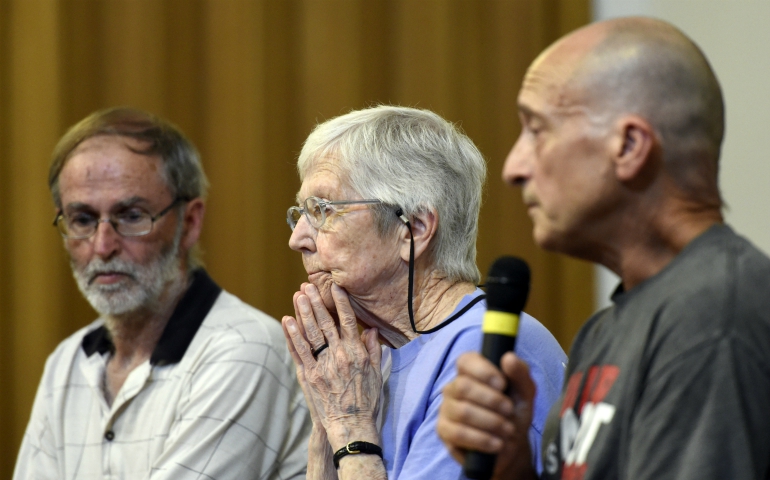
Greg Boertje-Obed, Sr. Megan Rice and Michael Walli speak to a gathering hosted by the Oak Ridge Environmental Peace Alliance at Church of the Savior Aug. 7, 2015, in Knoxville, Tennessee. (AP photo/Knoxville News Sentinel/Adam Lau)

ALMIGHTY: COURAGE, RESISTANCE, AND EXISTENTIAL PERIL IN THE NUCLEAR AGE
By Dan Zak
Published by Penguin Random House, 416 pages, $16.95
Almighty is the story of America’s love/hate relationship with nuclear weapons. The title is apt, capturing both the awe of this “pinnacle of human ingenuity” and the terror of the prospect of their use. Nuclear weapons claimed the public’s imagination in the 1940s through the 1960s, but almost disappeared from consciousness after the end of the Cold War.
In the last 70-plus years, the United States has spent $10 trillion developing and maintaining its arsenal and shrouding these acquisitions in secrecy. Today, nine nations possess these weapons, and the United States’ concern is how Iran and North Korea, especially, might use their capabilities. The election of President Donald Trump has escalated the stakes of nuclear engagement.
Almighty begins with the Manhattan Project in 1939 and traces the use and maintenance of these weapons through the 70th anniversary of the bombing of Hiroshima and Nagasaki in Japan. The origin of the book began in microcosm, when a young feature reporter for The Washington Post, Dan Zak, was assigned to cover the 2012 break-in of the Y-12 National Security Complex in Oak Ridge, Tennessee. The incident was touted as a huge security breach in America’s atomic complex and was covered by many newspapers, including The New York Times and NCR.
But the story came to haunt Zak. He confesses that he, like others in their 30s, grew up knowing nothing of the history of these deadly weapons. He had to write this book, for himself and his contemporaries. The incident of the break-in became the lens through which he saw the history of America’s preoccupation with these weapons. The result was Almighty.
The story is one of complexity, suspense, courage, secrecy, fear and pride. While the narrative of the lives of the three resisters in the 2012 break-in is central, the players are many. Scientists and politicians, bureaucrats and judges, jurists and attorneys, diplomats and ordinary people — each has an important role and a decided opinion.
One of the strengths of the book are the extensive interviews Zak did in local communities where nuclear weapons are an economic powerhouse and a cause of illness.
What holds this epic story together is the interspersed accounts of the three resisters, who are members of the Transform Now Plowshares. Each was profoundly influenced by a prophetic understanding of the Catholic faith. Michael Walli, a Vietnam veteran, was influenced by Jesuit Fr. Richard McSorley of Georgetown and by the Catholic Worker Movement. Greg Boertje-Obed, another veteran, became a conscientious objector, having been influenced by Jesuit Fr. Dan Berrigan and fellow Plowshares activists Phil Berrigan and Liz McAlister. And Megan Rice, a Sister of the Society of the Holy Child Jesus, as a young girl was inspired by Dorothy Day and went on to be a missionary teacher in Nigeria for 40 years.
This seemingly motley group, armed with hammers, box cutters and blood, entered undetected the Y-12 facility where uranium is enriched. They wrote graffiti, poured blood, hung up a banner and waited. This breach of security at Oak Ridge, the “Fort Knox of Uranium,” was considered a “miracle” by the resisters and their supporters but “catastrophic” for those who guarded this supposedly most secure of national facilities.
One of the book’s most gripping scenes is the courtroom trial, where the arguments for and against the defendants were laid out. The resisters’ claim was that nuclear weapons were immensely destructive, incapable of discriminating between military and civilian populations and hence needed to be destroyed. They accepted the charges against them.
The author’s sympathies are with the resisters, but he shows them as they are, with their quirks, limitations and sometimes-prophetic self-righteousness. It is by weaving their life histories into the larger chronicle of nuclear weapons that the account is saved from abstraction. Its rich detail gives it depth, its lucid prose makes it accessible, and its extensive documentation does not intrude on the flow of the narrative.
After I read Almighty, what remains in the imagination is the personal witness of the three protagonists, very ordinary Christians, who protested this most perilous of human creations and gave witness with their lives to Isaiah’s hope that swords would be beat into plowshares and spears into pruning hooks.
[Dana Greene is dean emerita of Oxford College of Emory University and serves on the board of the Shalem Institute for Spiritual Formation.]

